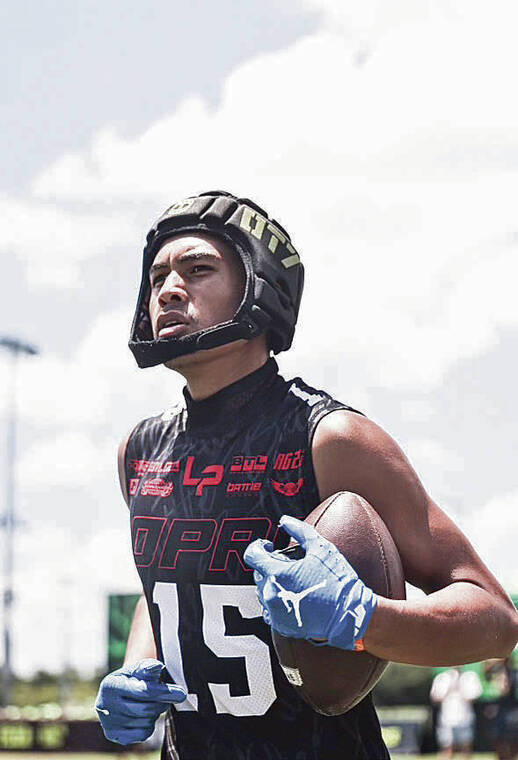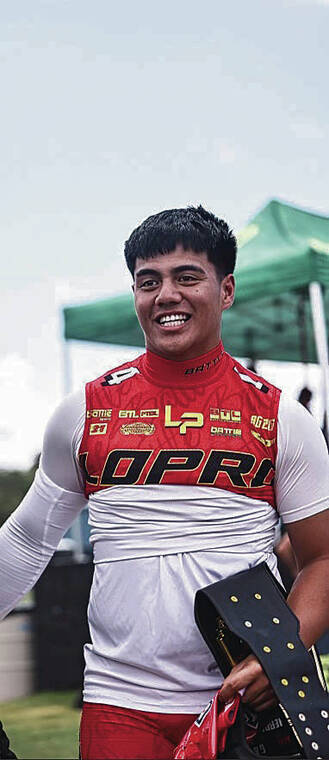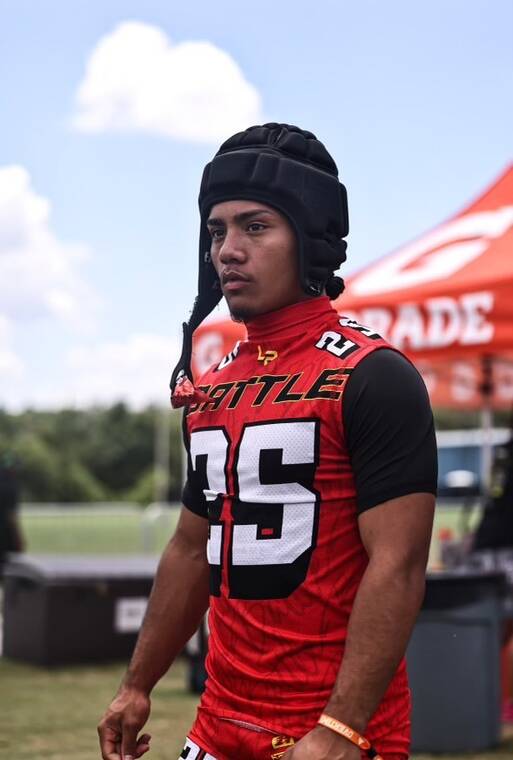7-on-7 football a popular source of evaluation, recruitment for Hawaii athletes

COURTESY KAJIHARA
Saint Louis’ Jordan Nunuha.

COURTESY KAJIHARA
Kahuku’s Aiden Manutai competed in the OT7 7-on-7 competitions on the mainland over the summer.

COURTESY KAJIHARA
Kapolei High’s Kaina Kamohali‘i.

COURTESY KAJIHARA
A player headed for pay dirt with a large video screen in the background during a 7-on-7 game.



In the early 1970s, pass-league games were held at Cooke Field, where high schools from around the state gathered to test their skill players among those from the University of Hawaii.
No media. No crowds. Just ball.
Cal Lee, the winningest head coach in Hawaii high school football history, was in his primitive years as a Saint Louis coach. Quarterback whisperer Vinny Passas and legendary UH head coach June Jones were but young pupils. And they were all present to witness the raw version of what is now more commonly referred to as 7-on-7 football.
Still years away from his stint as an assistant coach for his brother Ron during the revolutionary run-and-shoot years that ultimately led Kaiser High School to a historic win in the 1979 Prep Bowl, Cal ran the run-heavy wishbone offense at the time.
Who knew the sport, abbreviated to quarterbacks, wide receivers, running backs, defensive backs and linebackers, would become a serious tool to evaluate and recruit decades later?
“We’d always have 7-on-7 with other schools,” Cal Lee said.
Don't miss out on what's happening!
Stay in touch with breaking news, as it happens, conveniently in your email inbox. It's FREE!
“It wasn’t as big as it is now. It’s grown up huge. … You never had exposure like they’re having now.”
Last month, the NFL Network televised a number of games in OT7, a 7-on-7 league that featured some of the nation’s top high school football athletes across more than 30 teams.
Lo-Prospects was one of them. Although based in Las Vegas, Lo-Pro’s roster included mostly current or former Hawaii residents.
All of them landed on the big screen in OT7 nationals this year. Their competitive 38-28 semifinals loss came against four-star Notre Dame quarterback commit Deuce Knight and a Coastline Stars squad filled with other four- and three-star prospects.
Lo-Pro coach Jon Amano moved to the mainland only three years earlier, in 2021, but his mission to shed light on Hawaii-grown talent remained the same. And doing so from Las Vegas proved to be a lot more plausible.
Compared to Lo-Pro, which has the proximity to frequent a dozen or so mainland tournaments each year, the local All-Blacks Crusaders Football Club that Amano previously co-founded with Frank Lacaden, a longtime coach at Saint Louis, managed maybe two or three trips annually.
Opportunities to get that extra exposure, that extra star, can go a long way in today’s recruiting landscape.
Of the 23 players listed on Lo-Pro’s official OT7 roster, only seven are ranked by 247Sports, an industry-leading source for recruitment and transfer portal coverage. Bishop Gorman (Las Vegas) quarterback Maika Eugenio, wide receiver Kaina Watson and outside linebacker Champ Kapanui are among its three-star recruits with Hawaii ties, not to mention Saint Louis wide receiver Titan Lacaden, Frank’s son.
“The reason why we created Lo-Pro and what it stands for is, it’s actually low-profile athletes,” Amano said. “What that means to me is athletes that are frowned upon, that are underestimated always, and that are rarely given a chance. That’s pretty much who we are.”
A number of skill players from Hawaii have made waves via the 7-on-7 scene over the years, including but not limited to Saint Louis alums Tua Tagovailoa and Marcus Mariota. Both quarterbacks, each selected within the top five picks of the NFL Draft in the past decade, put the country on notice that skill players from the state can cut it at the next level, on the national stage.
“Marcus Mariota, I can say this,” said Campbell coach Darren Johnson, one of the early pioneers who took teams to Pylon, the earliest of national 7-on-7 tournaments established in 2006, “when they saw him throw in the (Pylon) tournament, everybody thought he was the best quarterback around. And all of a sudden, he ends up at Oregon — and he’s the best quarterback around.”
The chances that Hawaii’s next superstar quarterback, wide receiver, running back, linebacker, cornerback or safety surfaces at a 7-on-7 event?
Twenty years ago, never. Ten years ago, maybe. Today, more likely than not.
“When people used to come to recruit in Hawaii, it was mainly for our big boys — our linemen, our defensive linemen, our linebackers,” Amano said. “So nothing really with our skill players as far as quarterbacking, receiver play, defensive backs, safeties. It was very rare.
“What we’re doing here is providing this avenue for (those) kids.”

Hawaii Prep World
For high school sports record books, visit hawaiiprepworld.com Opens in a new tab.


